

Task-Based UI. Users Do Things This chapter introduces the concept of a Task Based User Interface and compares it with a CRUD style user interface.
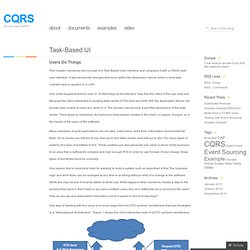
It also shows the changes that occur within the Application Server when a more task oriented style is applied to it’s API. One of the largest problems seen in “A Stereotypical Architecture” was that the intent of the user was lost. Because the client interacted by posting data-centric DTOs back and forth with the Application Server, the domain was unable to have any verbs in it. The domain had become a glorified abstraction of the data model.
Many examples of such applications can be cited. CQRS, Task Based UIs, Event Sourcing agh! Many people have been getting confused over what CQRS is.
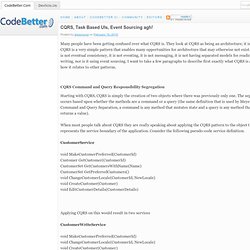
Eventual consistency, CQRS and interaction design. Gabriel Schenker’s excellent series of posts on “How we got rid of the database” offers a great insight on the benefits of a CQRS/ES application.
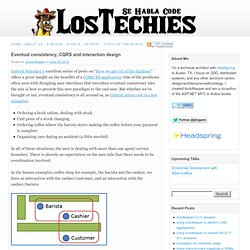
One of the problems often seen with designing user interfaces that introduce eventual consistency into the mix is how to present this new paradigm to the end user. But whether we’ve thought or not, eventual consistency is all around us, as Gabriel points out in a few examples: Ordering a book online, dealing with stockUnit price of a stock changingOrdering coffee where the barista starts making the coffee before your payment is completeOrganizing care during an accident (a little morbid) In all of these situations, the user is dealing with more than one agent/service boundary. There is already an expectation on the user side that there needs to be coordination involved. In the human examples, coffee shop for example, the barista and the cashier, we have an interaction with the cashier/customer, and an interaction with the cashier/barista: S Tech Journal: The CQRS dilemma and related random thoughts. I was very skeptical about CQRS (Command Query Responsibility Segregation) some time back, how ever after working on a CQRS implementation for the past few months for a customer in the telecom domain, I see better light.
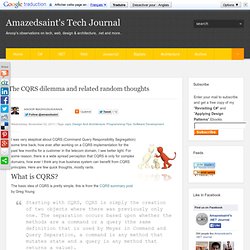
For some reason, there is a wide spread perception that CQRS is only for complex domains, how ever I think any true business system can benefit from CQRS principles. Here are few quick thoughts, mostly rants. Storage/uploads/2010/10/CQRS-big-picture.pdf. CQRS Pocket Guide - CQRS. Introduction to CQRS. Download Diary.CQRS.zip - 3.04 MB What is CQRS CQRS means Command Query Responsibility Segregation.
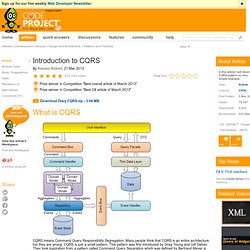
Many people think that CQRS is an entire architecture, but they are wrong. CQRS is just a small pattern. This pattern was first introduced by Greg Young and Udi Dahan. Commands - change the state of an object or entire system (sometimes called as modifiers or mutators).Queries - return results and do not change the state of an object. In a real situation it is pretty simple to tell which is which. Many applications that use mainstream approaches consists of models which are common for read and write side.
The real strength of these two patterns is that you can separate methods that change state from those that don’t. Another benefit of this pattern is in the case of large applications. Query side The queries will only contain the methods for getting data. Using CQRS you can avoid these projections. Command side Commands are created by the client application and then sent to the domain layer. The Benefits of WebSocket. By Peter Lubbers & Frank Greco, Kaazing Corporation (This article has also been translated into Bulgarian.) Lately there has been a lot of buzz around HTML5 Web Sockets, which defines a full-duplex communication channel that operates through a single socket over the Web.
HTML5 Web Sockets is not just another incremental enhancement to conventional HTTP communications; it represents a colossal advance, especially for real-time, event-driven web applications. HTML5 Web Sockets provides such a dramatic improvement from the old, convoluted "hacks" that are used to simulate a full-duplex connection in a browser that it prompted Google's Ian Hickson—the HTML5 specification lead—to say: "Reducing kilobytes of data to 2 bytes…and reducing latency from 150ms to 50ms is far more than marginal. Examples « CQRS. A Conceptual Model for Event Processing Systems. Introduction Enterprises in many domains have always behaved in an event-driven way and have had to deal with a growing volume of business events and transactions on a daily basis.
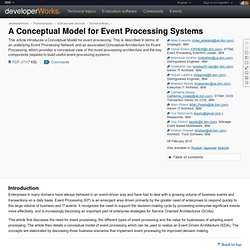
Event Processing (EP) is an emergent area driven primarily by the greater need of enterprises to respond quickly to this large volume of business and IT events. It recognizes the need to support the decision-making cycle by processing enterprise-significant events more effectively, and is increasingly becoming an important part of enterprise strategies for Service Oriented Architectures (SOAs). This article first discusses the need for event processing, the different types of event processing and the value for businesses of adopting event processing. Complex Event Processing Made Simple Using Esper. Introduction to Complex Event Processing (CEP) Event processing has been at the heart of any computing system for more then a decade.
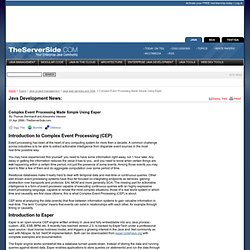
A common challenge across industries is to be able to extract actionable intelligence from disparate event sources in the most real-time possible way. You may have experienced this yourself: you need to have some information right away, not 1 hour later. Any delay in getting the information reduces the value it has to you...and you need to know when certain things are not happening within a certain time period, not just the presence of some events. Among those events you may want to filter a few of them and do aggregate computation over some period of time. Relational databases make it really hard to deal with temporal data and real-time or continuous queries. CEP aims at analyzing the data (events) that flow between information systems to gain valuable information in real-time. Complex Event Processing: DSL for High Frequency Trading.
Event Sourcing. Capture all changes to an application state as a sequence of events.

We can query an application's state to find out the current state of the world, and this answers many questions. However there are times when we don't just want to see where we are, we also want to know how we got there. Event Sourcing ensures that all changes to application state are stored as a sequence of events. Not just can we query these events, we can also use the event log to reconstruct past states, and as a foundation to automatically adjust the state to cope with retroactive changes.
How it Works The fundamental idea of Event Sourcing is that of ensuring every change to the state of an application is captured in an event object, and that these event objects are themselves stored in the sequence they were applied for the same lifetime as the application state itself. Let's consider a simple example to do with shipping notifications. Figure 1: A simple interface for tracking shipping movements. Event-Driven SOA: Events meet Services. By Guido Schmutz Achieve extreme loose coupling within a Service-Oriented Architecture by using event-driven interactions.
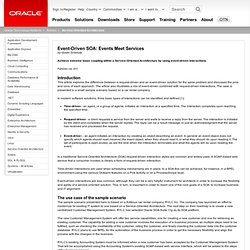
Published July 2011 Introduction This article explores the difference between a request-driven and an event-driven solution for the same problem and discusses the pros and cons of each approach. WebLogic Time and Event Driven Product Family (TED) The Java. Documentation.softwareag.com/webmethods/wmsuites/wmsuite8-2_sp2/Designer/8-2-SP2_Continuous_Query_Development_Getting_Started.pdf. Documentation. Drools Fusion. Esper - Complex Event Processing. 100% Open Source Complex Event Processor. Dist.codehaus.org/esper/OpenSpliceDDS-EsperCEP-webinar.pdf.